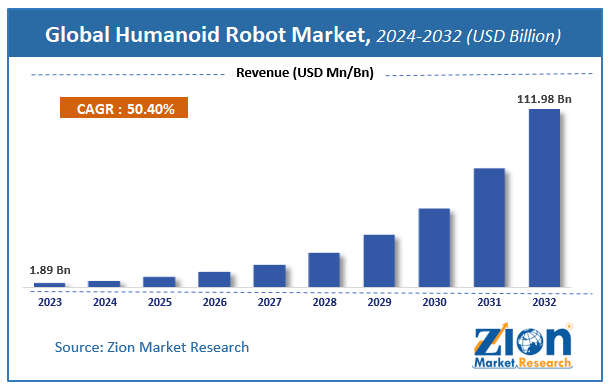Humanoid robots, once confined to the realm of science fiction, are rapidly evolving into a tangible reality with applications spanning across various industries. Driven by advancements in artificial intelligence (AI), robotics, and sensor technology, the global humanoid robot market is witnessing unprecedented growth, promising a future where robots seamlessly interact with humans in diverse environments. This article delves into the dynamic landscape of the humanoid robot market, exploring its current state, key drivers, challenges, and future projections.

Market Size and Growth:
The global humanoid robot market is estimated to be worth USD 14.39 billion in 2023 and is projected to expand at a CAGR of 37.58% from 2023 to 2030, reaching a staggering USD 147.56 billion by 2030. This exponential growth can be attributed to several factors:
Rising Demand for Automation: Industries are increasingly seeking to automate tasks, processes, and workflows to enhance efficiency, productivity, and cost-effectiveness. Humanoid robots are well-suited for this purpose, as they can perform repetitive tasks, handle hazardous materials, and operate in challenging environments.
Technological Advancements: Breakthroughs in AI, machine learning, computer vision, and sensor technology are enabling humanoid robots to become more intelligent, agile, and capable of sophisticated human-like interactions.
Expanding Applications: Humanoid robots are finding applications in a wide range of sectors, including manufacturing, healthcare, logistics, education, and entertainment.
Government Support and Investments:
Many governments worldwide are actively promoting the development and adoption of robotics through research grants, funding initiatives, and tax incentives.
Segmentation of the Market:
The humanoid robot market can be segmented based on various factors:
- By Application:
Manufacturing, Healthcare, Logistics, Education, Entertainment, Research & Development, Others
- By Height:
Under 1 meter, 1-1.5 meters, 1.5-2 meters, Above 2 meters
- By Payload Capacity:
Less than 5 kg, 5-10 kg, 10-20 kg, Above 20 kg
- By Degree of Freedom:
Less than 10, 10-20, 20-30, Above 30
- By End-User:
Large Enterprises, SMEs, Research Institutes, Educational Institutions
Key Players and Competitive Landscape:
The humanoid robot market is characterized by a mix of established players and emerging startups. Some of the prominent players in the market include:
Boston Dynamics: Known for developing highly agile and sophisticated humanoid robots, such as Atlas and Spot.
SoftBank Robotics America: Offers a range of humanoid robots, including Pepper and NAO, targeted at various applications.
Hyundai Motor Group: Actively investing in robotics technology, developing humanoid robots like H-Model for industrial and service applications.
Kawasaki Heavy Industries: A long-standing player in robotics, focused on industrial robots, including humanoid robots for manufacturing and logistics.
Tesla: Having forayed into humanoid robotics with Optimus, aiming to develop versatile robots for various tasks.
Challenges Facing the Market:
Despite the promising growth potential, the humanoid robot market faces several challenges:
High Costs: Developing and deploying humanoid robots remains expensive due to the complex technology involved, requiring specialized hardware and software.
Limited Functionality: While humanoid robots are becoming increasingly sophisticated, they still lack the dexterity, adaptability, and common sense reasoning of humans.
Safety and Ethical Concerns:
There are concerns regarding the safety of interacting with humanoid robots, particularly in shared environments, as well as ethical considerations related to job displacement and potential misuse.
- Regulatory Uncertainty: The rapid evolution of robotics technology necessitates clear and comprehensive regulations to address safety, liability, and ethical issues.
Future Outlook:
The future of the humanoid robot market appears bright, driven by continuous technological advancements, expanding applications, and growing industry adoption. Key trends likely to shape the market include:
- Enhanced AI Capabilities: Further advancements in AI and machine learning will enable humanoid robots to perform more complex tasks, understand and respond to human language and emotions more effectively, and learn from experiences.
- Greater Dexterity and Mobility:
Innovations in robotics will lead to humanoid robots with improved dexterity, balance, and agility, enabling them to navigate complex environments and perform intricate tasks.
Collaboration with Humans: Humanoid robots will increasingly be designed to work collaboratively with humans, leveraging the strengths of both to achieve common goals.
Personalized Applications:
Humanoid robots will become more personalized, tailored to specific user needs and preferences, with applications ranging from companionship and entertainment to healthcare assistance and education.
FAQ:
1. What are the main applications of humanoid robots?
Humanoid robots are finding applications in diverse sectors, including manufacturing for assembly and inspection, healthcare for patient assistance and rehabilitation, logistics for delivery and warehousing, education for interactive learning, and entertainment for human-robot interaction.
2. What are the key technological advancements driving the growth of the humanoid robot market?
Breakthroughs in AI, machine learning, computer vision, sensor technology, and materials science are enabling humanoid robots to become more intelligent, dexterous, and adaptable.
3. What are the main challenges facing the humanoid robot market?
High development costs, limited functionality compared to humans, safety and ethical concerns, and regulatory uncertainty are some of the key challenges.
4. What is the future outlook for the humanoid robot market?
The future of the market is bright, with continued technological advancements, expanding applications, and growing industry adoption driving market growth.
Conclusion:
The humanoid robot market is poised for substantial growth in the coming years, driven by technological advancements, diverse applications, and increasing industry adoption. While challenges remain, the potential benefits of humanoid robots in enhancing productivity, improving safety, and expanding human capabilities are undeniable.
As research and development continue to advance, humanoid robots are expected to become more sophisticated, versatile, and seamlessly integrated into our lives, transforming various industries and shaping the future of work and human-robot interaction.
Closure
Thus, we hope this article has provided valuable insights into The Rise of the Machines: A Deep Dive into the Global Humanoid Robot Market. We appreciate your attention to our article. See you in our next article!
